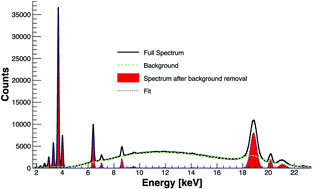Accuracy improvement in XRF analysis for the quantification of elements ranging from tenths to thousands μg g−1 in human tissues using different matrix reference materials†
Abstract
In this work, we aim at achieving the most accurate quantitative determination of elements in human tissues by means of X-ray Fluorescence spectrometry using the external calibration approach. A calibration curve built using a set of certified reference materials (CRM) of animal tissue was compared with the one obtained with a set of CRMs of plants and leaves with lower atomic number Z but with correction of the matrix using the scattering peaks of the X-ray tube anode. Finally, a calibration curve combining the two sets of CRMs was built and the accuracy of the quantification using the three methods was compared and a more precise method of quantification was obtained. This improved approach was tested on five paired samples of normal and tumour human tissue. Despite the high heterogeneity of the samples, and given the improvement in accuracy of the measurements, significant differences were found in the elemental concentration of low-Z elements.



 Please wait while we load your content...
Please wait while we load your content...